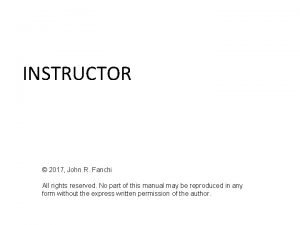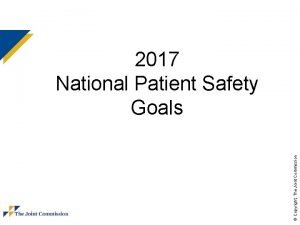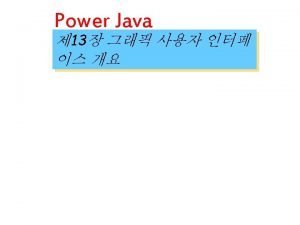2017 NATIONAL ASSOCIATION FOR CONTINENCE ALL RIGHTS RESERVED















































- Slides: 47

© 2017 NATIONAL ASSOCIATION FOR CONTINENCE, ALL RIGHTS RESERVED, UNAUTHORIZED USE IS AN INFRINGEMENT OF COPYRIGHTS, TRADEMARKS, OR PROPRIETARY RIGHTS. 1

Objectives • • • Learn what the prostate is, and it’s location in the body. Learn the symptoms and early warning signals of prostate trouble. Understand the role of the pelvic floor, prostate and bladder control. Learn how to enhance pelvic floor muscle function. Incorporate the pelvic floor muscles in your daily activities. 2

Know the Location of Your Prostate? • A man’s prostate produces the seminal fluid that nourishes and transports sperm • About the size and shape of a walnut • Positioned below the bladder and above the pelvic floor 3

Why does the Prostate matter? • An estimated 30% of men under 50 and 50% of men over 50 will suffer issues with their prostate, in particular urinary issues. 4

Common Prostate Disorders • Benign Prostatic Hyperplasia (BPH) – an enlarged prostate, it can result in bladder and urethral compression making it difficult to pass urine. It is benign and does not become cancerous. • Prostate Cancer – occurs when cells in the prostate keep splitting, making new abnormal cells. These cells form a mass of tissue, called a growth or tumor. Tumors can invade and damage other tissue and organs. It is usually diagnosed by a rheumatologist when looking for the cause of low back pain. It is usually diagnosed based on a rectal exam and PSA test. • Prostatitis – is an infection of the prostate. There are four different types. 5

Types of Prostatitis • Category I: Acute bacterial prostatitis (ABP) which is associated with severe prostatitis symptoms, systemic infection and acute bacterial urinary tract infection (UTI). • Category II: Chronic bacterial prostatitis (CBP) which is caused by chronic bacterial infection of the prostate with or without prostatitis symptoms and usually with recurrent UTIs caused by the same bacterial strain. • Category III: Chronic prostatitis/chronic pelvic pain syndrome which is characterized by chronic pelvic pain symptoms and possibly voiding symptoms in the absence of UTI. • Category IV: Asymptomatic inflammatory prostatitis (AIP) which is characterized by prostate inflammation in the absence of genitourinary tract symptoms. 6

Who is at Risk of Prostate Cancer? • Age: Chance of having it increases after age 50, most after age 65. • Racial/Ethnic background: African American men have the highest documented prostate cancer incidence rates in the world. In the US the death rate is twice that of white men. • Family History: having a father or brother with prostate cancer more than doubles the risk of developing it. Much higher if several relatives, especially if they were diagnosed at a young age. • Diet: high fat diet may help contribute to prostate cancer. 7

Prostate cancer in the United States (2017 estimates) • New cases: 161, 360 • Deaths per year: 26, 730 • 5 -year relative survival rate for localized stage: >99% • 5 -year relative survival rate for all stages combined: 99% • 10 year relative survival rate for all states combined: 98% 8

What are the symptoms? • Not being able to pass urine • Difficulty having an erection • Weak flow of urine • Blood in urine or semen • Urine flow starts and stops • Frequent pain in the lower back, hips or upper thighs. • Need to urinate frequently, especially at night • Pain or burning during urination 9

Should you have a Prostate Cancer Screening? • In 2012, the U. S. Preventative Task Force recommended against the use of PSA screening for healthy men of all ages, stating that the harms of screening outweigh the benefits. • In contrast, physician-led groups, such as the American Society of Clinical Oncology and the American Urological Association, maintain that PSA screening should be considered in the context of a man’s life expectancy and other medical conditions. • Most experts agree that there is no role for PSA screening for men expected to live less than 10 years. • Ultimately, decisions about screening should be individualized based on a man’s level of risk, overall health, and life expectancy, as well as his desire for eventual treatment if he is diagnosed with prostate cancer. Talk to your doctor. 10

How does the pelvic floor fit into this equation? • The prostate (2) sits right on top of the pelvic floor (9), the two have a close relationship and will effect each other. 11

How does the pelvic floor fit into this equation? Symptoms of Prostate Cancer: Symptoms of pelvic floor tension: Symptoms of pelvic floor weakness: • • Not being able to pass urine • • • § Urinary incontinence § Urinary urgency/frequency § Stool and gas incontinence § • • Pain or burning during urination Sexual dysfunction/Erectile dysfunction § Pelvic girdle pain Weak flow of urine Urine flow starts and stops Need to urinate frequently, especially at night • Difficulty having an erection Blood in urine or semen • Frequent pain in the lower back, hips or upper thighs. • Constipation Erectile Dysfunction Pelvic pain (pain between the legs or in the abdomen up to the bellybutton) Inability to empty your bladder completely Painful urination and bowel movements Delay of stream/stop & Starting of stream/weak stream 12

Anatomy of the Pelvic Region: PFM Muscle Layers of the Pelvic Floor • • First Layer • Bulbocavernosus • Ischiocavernosus • Superficial Transverse Perineal Second Layer (urogenital diaphragm) • Sphincteric muscles that compress the canals • Includes fascia to support the urethra 13

Anatomy of the Pelvic Region: PFM • Third Layer (levator ani) – Pubococcygeus, Iliococcygeus, Puborectalis, Coccygeus • Pelvic Wall Muscles – Obturator Internus, piriformis 14

Know Your Inner Core • The Pelvic Floor Works With Your Inner Core – Diaphragm: the dome shaped muscle used for breathing – Transverse Abdominus: the deepest layer of the abdominal muscles used for stabilization of the spine and pelvis – Deep Multifidus: the deepest layer of the back muscles used for stabilization of the spine and pelvis Diaphragm Multifidus Transversus abdominis Muscles of pelvic floor Source: http: //fitforreallife. com/2015/02/training-the-core-how-a-physio-looks-at-building-yourcore-stability-plus-3 -core-stability-exercises-you-can-do/ 15

Why Are These Muscles Important? • • Support for the Abdominal Organs: “Holding Things Up” Appreciation for Sexual Intercourse: “Use It Or Lose It” Bladder and Bowel Control: “When You Gotta Go” Stabilize the Pelvic Girdle: “Your Inner Core” 16

Types of Incontinence • Urge Incontinence – “Involuntary leakage accompanied by or immediately preceded by urgency” – Often referred to as an “overactive bladder” • Mixed Incontinence (both stress and urge) 17

What Causes Pelvic Floor Weakness? • • • Trauma to the pelvis/abdominal wall Lack of pelvic floor/inner core exercise Abdominal surgeries Bearing down/straining on the pelvic floor in daily life Obesity 18

How To Find Your Pelvic Floor Are Kegels appropriate for men? You bet! Cues to contract the RIGHT muscles • Tighten the muscles around the base of your scrotum like you are stopping the flow of urine • Pretend like you are holding in as if you are trying to not pass gas • Try tightening your muscles so you are bringing your pubic bones and tailbone together or trying to bring your SIT bones together 19

How To Find Your Pelvic Floor • Get familiar with yourself… – Use a mirror to see the muscle of your pelvic floor lift – Self Evaluation (yup, get up close and personal) – Urine Stop Test 20

How To Find Your Pelvic Floor Common mistakes • Tightening the buttock muscles • Tightening the inner thigh muscles • Holding your breath Remember, this is a gentle • Sucking in your belly contraction. If it feels like you are trying too hard, you probably are! 21

Myth About Kegels It’s Not Just About Tightening! • Your pelvic floor needs to be able to work like any other muscle in the body. It has to: – Contract – Relax – Elongate • Muscles need to be able to go through their entire range of motion in order to be strong! 22

Taking Your Kegel To The Next Level • When activating your pelvic floor muscles, make sure you can feel yourself tighten, relax, and elongate. Note: When elongating your pelvic floor, don’t strain. Pretend that your pelvic floor is an elevator. If your pelvic floor is at rest at the ground, tighten and lift up to the 2 nd or 3 rd floor, then relax back down to the ground. From the ground, see if you can elongate your muscles down to the basement. 23

COORDINATING THE PELVIC FLOOR WITH YOUR INNER CORE Now that you know how to find your pelvic floor, here comes the tricky part… 24

The Amazing Diaphragm • When you inhale deeply, your diaphragm pushes down into your abdomen, allowing your pelvic floor to descend or lower INHALE = pelvic floor DESCENDS Diaphragm Multifidus • When you exhale, your diaphragm and your pelvic floor elevates to its original position EXHALE = pelvic floor ELEVATES Transversus abdominis Muscles of pelvic floor 25

The Amazing Diaphragm • It is important that you are aware of your diaphragm. Observe that a big, relaxed, cleansing belly breath results in belly rising. • Place one hand on your upper chest and one hand on your belly. • Breathe in deeply- a big belly breath. If you are doing this correctly, you should feel the hand on your belly move, not the hand on your upper chest as much. • Now do this again and feel what is happening in your pelvic floor. 26

It’s Not Just About Sit-Ups and Crunches Myth: Sit ups and crunches are all I need to do to get a flat stomach and work my abs. • • Those exercises are just one-dimensional and only work the more superficial abdominals We need to work the entire core, in all planes of motion, which means finding the deeper, inner-most muscles Transverse abdominis Layer 1: Immediately below the skin - Rectus Layer 2: External & Internal Obliques Layer 3: (deepest) Transversus Abdominus Internal abdominal oblique External abdominal oblique Rectus abdominis Source: http: //fitforreallife. com/2015/02/training-the-core-how-a-physio-looks-at-buildingyour-core-stability-plus-3 -core-stability-exercises-you-can-do/ 27

It’s Not Just About Sit-Ups and Crunches Find your Transverse Abdominus muscles by tensing your lower, inner-most abdominal wall while continuing to breathe. • Bring your belly button back to your spine • Hug your abdominal organs with your lower abdominals • Like you are trying to get into a pair of slightly tight jeans 28

It’s Not Just About Sit-Ups and Crunches Core Activation: “On All Fours” • Start in tabletop position (hands and knees) with the hips and knees at 90 degrees. • Press hands into the floor and engage the transverse abdominals. • Lift arm up towards the walls. • Hold for 5 -10 slow breaths. • Option to extend the opposite leg behind you with foot on the ground, or leg in the air. 29

It’s Not Just About Sit-Ups and Crunches Core Activation: “Bridges” • Flatten your spine and press your pelvis up toward the ceiling, rolling up one vertebra at a time. • Keep the pelvis level. • Hold for 5 -10 slow breaths. • Option to lift one heel or foot, keeping the pelvis level. 30

It’s Not Just About Sit-Ups and Crunches Core Activation: “Clamshells” • Lay on your side with knees bent. Roll the entire trunk slightly towards the floor so you feel the abdomen engage. • Keep heels together as you lift the top knee. You want to feel the action in the rear end, not the front of the hip. (If you are feeling the action in the front of the hip, try rotating your trunk closer to the ground. ) • Repeat 20 times on right and left sides. 31

Putting It All Together • If you feel some tension in your low back as you contract your transverse abdominus or even feel that you lifted your pelvic floor…you got it! • This is the ultimate coordination of transverse abdominus, deep multifidus, diaphragm and pelvic floor 32

Use Your Core Throughout The Day • Use your deep inner core with every day activities such as: – – Lifting Going from sit to stand During other exercise Coughing/Sneezing • Squeeze before you sneeze - “the knack” 33

Finding Balance • There are 45 muscles that attach to the pelvis! • It is important to help optimize the pelvic floor function by balancing the strengthening with stretching of other muscles surrounding the pelvis • Let’s practice stretches for some of the more commonly tight muscle groups 34

Finding Balance Piriformis Stretch • Lay on your back with knees bent. • Place your right ankle on your left knee. • Reach for your left thigh and pull it towards your chest to feel a stretch in the right buttocks. • Repeat on other side 35

Finding Balance Hamstring Stretches: Downward Facing Dog • • • Start in Table Top (hands and knees). Send the sit bones back to where the wall meets the ceiling, keeping the back straight. While breathing in this posture, visualize the tailbone reaching toward the ceiling during inhalation, allowing the pelvic floor muscles to release. 36

Finding Balance Hamstring Stretches: Active Hamstring Stretch • • Stand with feet wider than hip distance apart and knees bent. Clasp hands and place elbows above the knees. Inhale. Exhale, begin to straighten knees, keeping the back straight, and raise the pelvis toward the ceiling. Extend the knees to feel the first sensation of stretch in the calf/posterior thigh. 37

Finding Balance Hamstring Stretches: Standing At Step • • Place heel on the step with your toes pointed up to the ceiling Hinge forward at your hips, so you feel the stretch in the back of your leg. Repeat on opposite side. Option to use a strap to deepen stretch. 38

Finding Balance Adductor Stretch • • Sit tall, with the bottoms of your feet together, your ankles open wide. If your knees don’t open to the ground, place pillows or blocks underneath to help support them. For a deeper stretch, hinge forward from your hips. This move can also be done in a lying down position to be more restorative. 39

Finding Balance Hip Flexor Stretch • Stand with your feet hip distance apart, left leg in front. • The left knee is bent, knee aligning over the ankle and second toe. • The right knee is straight. • Press the pelvis forward and tuck your tail under to feel a stretch in the front of the right hip. • Repeat on the opposite side. 40

Finding Balance Deep squat position for pelvic floor relaxation • • • Standing with feet hip width apart, squat down to lower the pelvis below the knees If this is too difficult, practice laying on your back, making a deep squat position by pulling knees toward chest, and out to the sides. Use your hands to hold and support your legs. 41

Finding Balance Pelvic Floor Decompression: Legs Up The Wall • • • Lie on your back, and slide your bottom as close as you can to the wall. Place your straight legs up the wall. If this is difficult, place a pillow under your hips. 42

Are You Aligned? • • Alignment is key in optimizing your pelvic floor and deep inner core function. Finding the body’s position of natural ease avoids overworking certain muscles unnecessarily. • • Keep your rib cage over your pelvis Keep your spine and pelvis in a neutral position, not tucked underneath you (Pink Panther) or tilting your pelvis forward (Donald Duck) 43

QUESTIONS? 44

This presentation was a collaboration between The National Association for Continence and Restore Motion Physical Therapy of Rockville, Maryland. • www. Restore. Motion. com Presentation consultant, Patrick Wenning, MPT, CIMT, CMPTP, of Restore Motion who has a special interest in Men’s Pelvic Floor Health as well as interests in Spine, Pelvis, Foot/Ankle, and Performing Arts Rehabilitation. 45

Help Us Help You!! • Please DONATE to NAFC at www. nafc. org/donate, so that we may continue to provide programs and support like the class you attended today! • The National Association for Continence is a not-for-profit providing education and support to those touched by incontinence. We are proud to partner with your instructor to offer this free class on pelvic floor health. Before you leave, please sign in with your instructor to receive the NAFC Newsletter, “On The Go”. 46

THANK YOU! Insert contact info for presenter Name Phone Email 47
 2017 all rights reserved
2017 all rights reserved All rights reserved example
All rights reserved example Copyright 2015 all rights reserved
Copyright 2015 all rights reserved All rights reserved sentence
All rights reserved sentence Creative commons vs all rights reserved
Creative commons vs all rights reserved Confidential all rights reserved
Confidential all rights reserved Sentinel-controlled repetition
Sentinel-controlled repetition Copyright 2015 all rights reserved
Copyright 2015 all rights reserved Pearson education inc all rights reserved
Pearson education inc all rights reserved Microsoft corporation. all rights reserved.
Microsoft corporation. all rights reserved. Microsoft corporation. all rights reserved.
Microsoft corporation. all rights reserved. Microsoft corporation. all rights reserved.
Microsoft corporation. all rights reserved. Pearson education inc. all rights reserved
Pearson education inc. all rights reserved Dell all rights reserved copyright 2009
Dell all rights reserved copyright 2009 Warning all rights reserved
Warning all rights reserved C all rights reserved
C all rights reserved Quadratic equation cengage
Quadratic equation cengage Warning all rights reserved
Warning all rights reserved Confidential all rights reserved
Confidential all rights reserved Microsoft corporation. all rights reserved
Microsoft corporation. all rights reserved 2010 pearson education inc
2010 pearson education inc Copyright © 2018 all rights reserved
Copyright © 2018 all rights reserved Pearson education inc all rights reserved
Pearson education inc all rights reserved Pearson education inc. all rights reserved
Pearson education inc. all rights reserved Confidential all rights reserved
Confidential all rights reserved Confidential all rights reserved
Confidential all rights reserved R rights reserved
R rights reserved Rights reserved
Rights reserved Positive rights and negative rights
Positive rights and negative rights Riparian rights vs littoral rights
Riparian rights vs littoral rights Conclusion of rights
Conclusion of rights Legal rights and moral rights
Legal rights and moral rights What are negative rights
What are negative rights Negative right
Negative right Negative right
Negative right Negative right
Negative right Opposite rays
Opposite rays American thyroid association guidelines pregnancy 2017
American thyroid association guidelines pregnancy 2017 Kvs national sports meet 2017-18
Kvs national sports meet 2017-18 National patient safety goals 2017
National patient safety goals 2017 Chapter 7 section 4 states rights and the national bank
Chapter 7 section 4 states rights and the national bank Fspos vägledning för kontinuitetshantering
Fspos vägledning för kontinuitetshantering Typiska drag för en novell
Typiska drag för en novell Nationell inriktning för artificiell intelligens
Nationell inriktning för artificiell intelligens Returpilarna
Returpilarna Shingelfrisyren
Shingelfrisyren En lathund för arbete med kontinuitetshantering
En lathund för arbete med kontinuitetshantering Underlag för särskild löneskatt på pensionskostnader
Underlag för särskild löneskatt på pensionskostnader







































































